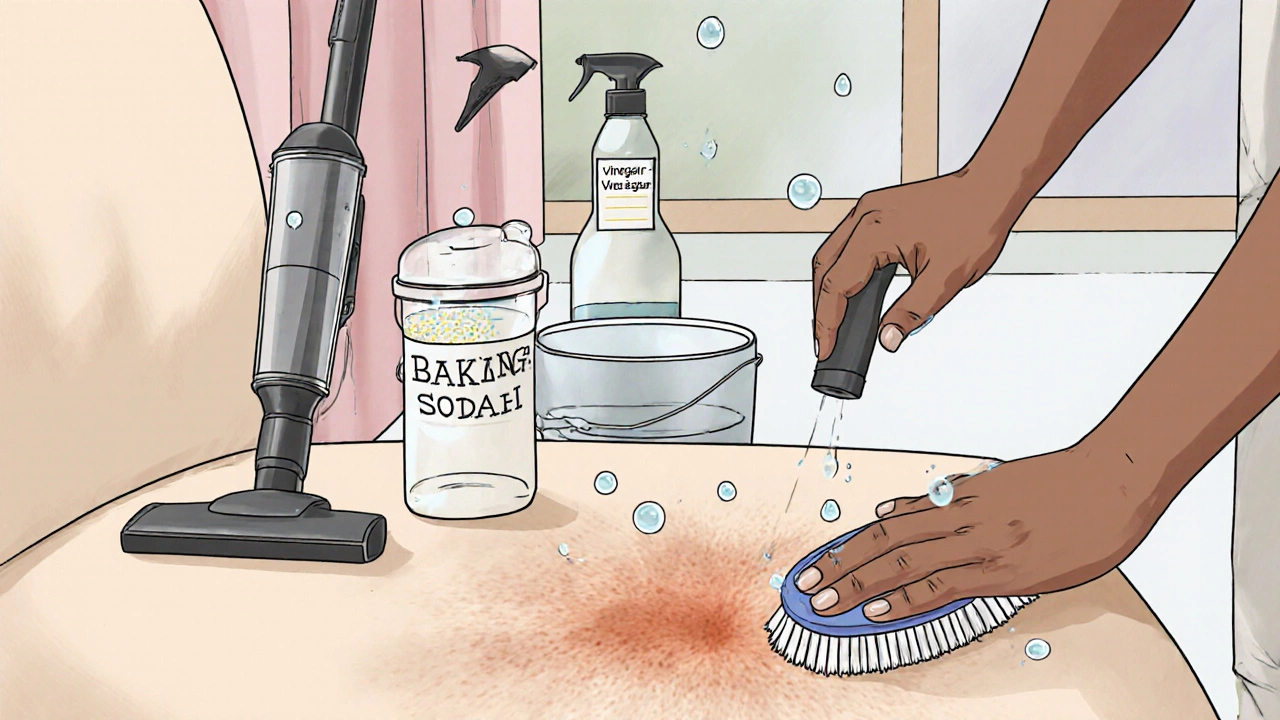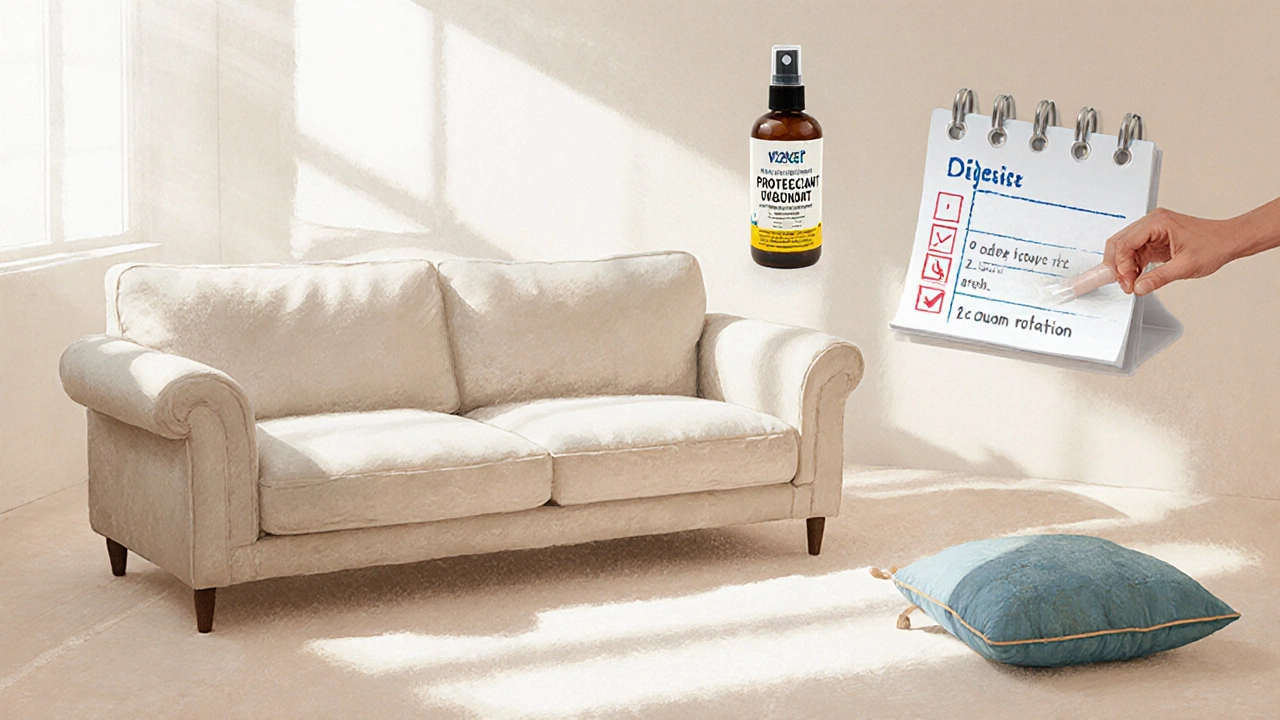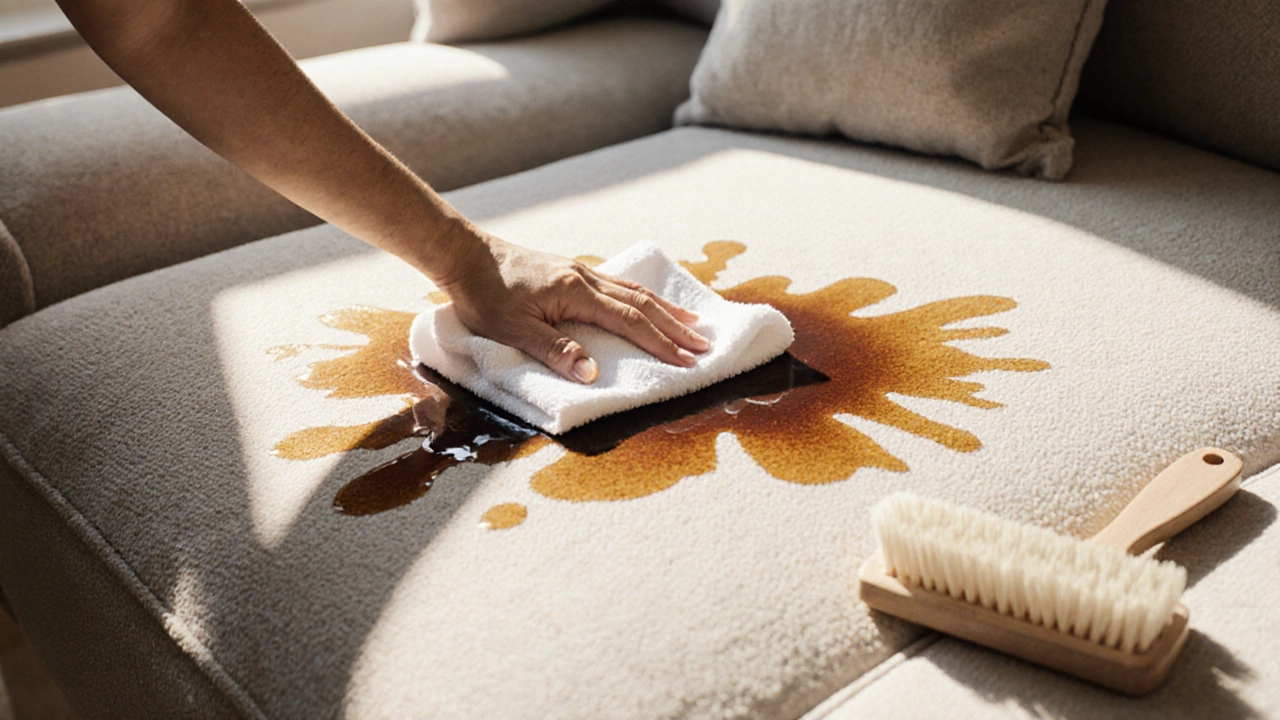Upholstery Cleaner Recommender
When you spot a fresh spill on your favourite couch, the first thought is "How do I get this out without ruining the fabric?" The answer lies in a systematic, fabric‑friendly approach that tackles the stain, protects the material, and leaves the upholstery looking as good as new. Below is a step‑by‑step guide that works for most couch fabrics, plus deeper‑cleaning options for tougher jobs.
What Upholstery cleaning actually means
Upholstery cleaning is the process of removing dirt, oils, and stains from the surface and fibers of furniture fabrics. It’s not just a quick wipe‑down; proper cleaning restores breathability, prevents mold, and extends the life of the couch.
Know your fabric before you start
Different fabrics react differently to moisture, heat, and chemicals. Identify the material by checking the manufacturer’s tag (look for codes like W for water‑based cleaners, S for solvent‑only, or X for vacuum‑only). Common couch fabrics include:
- Microfiber - synthetic, highly absorbent, tolerates mild water solutions.
- Leather - needs leather‑specific conditioners; avoid excess water.
- Cotton/linen blends - can handle gentle cleaning agents but may shrink with heat.
- Synthetic blends - often W‑rated, safe for most household cleaners.
Knowing the fabric type determines which cleaning solution you’ll use and whether a steam‑clean or dry‑clean method is safest.
Identify the stain type
Stains fall into three broad categories, each requiring a different treatment:
- Oil‑based (grease, lipstick, butter) - need surfactants to break down the oil.
- Protein‑based (blood, milk, egg) - require cold water and enzymatic cleaners.
- Water‑based (coffee, juice, paint) - usually respond well to mild acids or neutral cleaners.
Once you know the category, you can pick the right solution from the table below.
Gather your tools and cleaning agents
Having the right gear ready saves time and prevents the urge to improvise with harsh chemicals.
- Vacuum cleaner with an upholstery attachment - removes loose dust before wet work.
- Soft‑bristle brush - gently agitates fibers without tearing.
- Microfiber cloth - ideal for blotting and wiping.
- Cleaning solutions (see comparison table):
- White vinegar (1 part vinegar to 2 parts water) - mild acid for water‑based stains.
- Baking soda - absorbent powder for odors and light oil spots.
- Commercial upholstery cleaner (pH‑neutral) - formulated for a range of fabrics.
- Dry cleaning solvent - for delicate leather or “S”‑only fabrics.
- Steam cleaner (optional) - deep‑cleaning without chemicals.

Quick‑step cleaning guide (for most W‑rated fabrics)
- Vacuum first. Run the upholstery attachment slowly over the entire couch to lift crumbs and dust.
- Spot‑test. Apply a tiny amount of your chosen cleaner to an inconspicuous area. Wait 5‑10 minutes; if the color stays unchanged, you’re safe to proceed.
- Blot, don’t rub. For fresh spills, use a clean white cloth to blot up as much liquid as possible. Press gently - rubbing can push the stain deeper.
- Apply the cleaner. Spray (or dab) the solution onto a microfiber cloth, not directly onto the couch. Work from the outside of the stain toward the center.
- Agitate lightly. Use the soft‑bristle brush in small, circular motions for stubborn spots. Keep the brush damp, not soaked.
- Rinse (if needed). Dampen a separate cloth with plain water and blot the area to remove residue. Excess moisture can lead to mildew, so limit water.
- Dry. Press a dry towel over the cleaned spot, then let the couch air‑dry for at least 30 minutes. A fan or open window speeds up the process.
Repeat steps 3‑6 for each stain. For oil‑based stains, start with a sprinkle of baking soda, let sit 15 minutes, then vacuum before applying the vinegar solution.
Deeper cleaning options
If the couch looks dull or you’re tackling an entire sofa, consider these methods:
- Steam cleaning. Fill the steam cleaner with water (add a few drops of gentle detergent if allowed). Move the head slowly over the fabric; steam loosens embedded dirt while the heat kills dust mites. Allow the couch to dry fully before use.
- Dry‑cleaning solvent. For “S”‑only or leather upholstery, apply a solvent‑based cleaner to a cloth and gently rub the surface. Follow with a leather conditioner to prevent drying.
- Professional extraction. Rental carpet‑cleaner machines with upholstery attachments use hot water extraction. They’re effective but require careful drying to avoid mold.
Maintenance routine to keep stains at bay
Regular upkeep makes deep cleaning easier. Follow this weekly schedule:
- Vacuum the couch at least once a week, paying special attention to crevices.
- Spot‑clean spills within five minutes - the faster you act, the less chance of a set‑in stain.
- Rotate and fluff cushions monthly to distribute wear.
- Apply a fabric protectant (spray‑on or wipe‑on) every 6‑12 months. It creates a microscopic barrier against liquids.

Common pitfalls and how to avoid them
- Over‑wetting. Too much water saturates the padding, leading to odor or mold. Always wring out cloths well.
- Using harsh chemicals. Bleach, ammonia, or strong acids can discolor or weaken fibers. Stick to pH‑neutral or mild natural solutions.
- Skipping the spot‑test. A bright color‑fast fabric can still fade if exposed to a new cleaner. The test saves your couch.
- Rubbing stains. This spreads the pigment. Blotting absorbs the spill without smearing.
Comparison of popular cleaning solutions
| Cleaner | Best for stain type | pH level | Fabric safety | Cost (US$) |
|---|---|---|---|---|
| White vinegar (1:2 mix) | Water‑based, light oil | 2.5 (mild acid) | Safe on most W fabrics, avoid leather | 0.5 |
| Baking soda | Odor, grease | Neutral | All fabrics; leaves residue if not vacuumed | 0.2 |
| Commercial upholstery cleaner (pH‑neutral) | All stain types | 7 (neutral) | Label‑approved for W, S, and X fabrics | 5‑10 per bottle |
| Dry cleaning solvent | Oil‑based, delicate leather | Varies (solvent) | Only S‑rated and leather | 8‑12 |
| Steam cleaner | Deep dirt, dust mites | Neutral (steam) | W fabrics; avoid on S‑only or unsealed leather | 100‑200 (rental) |
Putting it all together - a quick checklist
- Check the couch tag (W, S, or X).
- Identify the stain (oil, protein, water).
- Gather vacuum, brush, microfiber cloth, and the right cleaner.
- Spot‑test in an hidden area.
- Follow the 7‑step cleaning routine.
- Dry completely before re‑using.
- Schedule weekly vacuuming and monthly protectant.
Frequently Asked Questions
Can I use regular dish soap on my couch?
A mild dish soap diluted 1‑to‑10 with water works on many W‑rated fabrics, but always spot‑test first. It can leave a film on leather, so avoid it there.
How often should I deep‑clean my sofa?
Every 12‑18 months is a good rule, unless you have pets or kids, in which case twice a year keeps allergens at bay.
Is steam cleaning safe for leather sofas?
No. Steam introduces moisture that can damage leather. Use a leather‑specific cleaner and follow with a conditioner.
What’s the fastest way to get rid of coffee stains?
Blot the spill, sprinkle baking soda, let sit 10 minutes, vacuum, then treat with a vinegar‑water mix. The baking soda lifts the pigment; vinegar breaks it down.
Can I rent a professional upholstery cleaner?
Yes, many hardware stores rent carpet‑extractor machines with upholstery attachments. Follow the manufacturer’s instructions to avoid over‑wetting.





